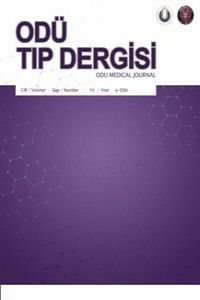Bir Yıllık Endometrial Örneklerin Retrospektif İncelenmesi: 705 Olgunun Analizi
Amaç: Endometrial spesmenler günlük patolojiye gelen örnekler içinde en sık rastlanılan örneklerdendir.Endometrium örneklemesi, endometrium yaşının belirleme ve yapısal bozuklukları tespitte (polip, leiomyom vs) önemlidir. Endometrium örneklemede en sık; dilatasyon&küretaj ve endometrial biyopsi uygulanmaktadır. Endometrial spesmenlerde; endometrial polip, endoservikal polip, düzensiz proliferatif endometrium, basit-kompleks atipili-atipisiz hiperplazi, endometrial intraepitelyal neoplazi, endometrial karsinom tanı başlıkları irdelenerek bir yıllık oranlarını, literatür ve yaş korelasyonunu sorgulamak amaçlanmıştır.
Yöntemler: Ordu Eğitim Araştırma Hastanesinde 2018 yılına ait endometrium küretaj, biyopsi, histerektomi uygulanan 19-77 yaş aralığında toplam 705 kadın hastaya ait patoloji raporları retrospektif olarak değerlendirilmiştir.
Bulgular: Hastaların yaş ortalamaları 46,93±9,04 olarak saptanmıştır. Endometrial polipler 243 olguda (%34,5) saptanmıştır. Yaşı elli ve üzeri olanlarda endometrioid tip endometrial adenokarsinom tanısı alanların oranı 76,5 iken yaşı ellinin altında olanlarda endometrioid tip endometrial adenokarsinom tanısı alanların oranı 23,5 olarak saptanmıştır. Elli yaş altında basit atipisiz endometrial hiperplazi olanların oranı %66,7 iken yaşı elli ve üzeri olanlarda 33,3’dür. Elli yaş altında kronik endometrit olanların oranı %87,5 iken yaşı elli ve üzeri olanlarda 12,5 olarak saptanmıştır.
Sonuç: Endometrial polipler 243 olguda (%34,5) saptanmış olup en çok görülen patoloji olarak saptanmıştır. Endometrium spesmenlerinde postmenapozal grupta malignite riski daha yüksek izlenmektedir, bu nedenle özellikle postmenapozal dönemde olmak üzere ve ayrıca reproduktif dönemde anormal uterin kanama varlığında endometrial örnekleme yapılması endometrial malignite tespiti açısından çok önemlidir.
Retrospective Examination of One-Year Endometrial Samples: Analysis of 705 Cases
Objective: Endometrial specimens are among the most common specimens found in daily pathology. Endometrial sampling is important in determining the age of the endometrium and detecting structural disorders (polyps, leiomyomas, etc.). Dilatation & curettage and endometrial biopsy are the most common applications for endometrial sampling. It was aimed to examine the diagnosis titles of endometrial polyp, endocervical polyp, irregular proliferative endometrium, simple-complex hyperplasia with or without atypia, endometrial intraepithelial neoplasia, endometrial carcinoma in endometrial specimens and to question their one-year rates, literature and age correlation.
Methods: Pathology reports of 705 female patients aged 19-77 years who underwent endometrial curettage, biopsy, and hysterectomy in 2018 at Ordu Training and Research Hospital were evaluated retrospectively.
Results: The mean age of the patients was 46.93±9.04 years. Endometrial polyps were detected in 243 cases (34.5%). While the rate of those diagnosed with endometrioid type endometrial adenocarcinoma in those aged fifty and over was 76.5, the rate of those diagnosed with endometrioid type endometrial adenocarcinoma in those under the age of fifty was 23.5. While the rate of endometrial hyperplasia without simple atypia is 66.7% under the age of 50, it is 33.3 in those aged 50 and over. While the rate of chronic endometritis under the age of 50 was 87.5%, it was determined as 12.5 in those aged 50 and over.
Conclusion: Endometrial polyps were detected in 243 cases (34.5%) and were found to be the most common pathology. The risk of malignancy is higher in the postmenopausal group in endometrial specimens; therefore, endometrial sampling is very important for the detection of endometrial malignancy, especially in the postmenopausal period and also in the presence of abnormal uterine bleeding during the reproductive period.
___
- 1. Çintesun E, Çintesun FN, Karataş Aslan B, Uçar MG, Yarıkkaya E. Endometrial Örnekleme Sonuçlarımız: 655 Olgunun Analizi. Selcuk Medical Journal. 2012;28(3):163-166.
- 2. Munro MG, Critchley HO, Broder MS, Fraser IS, Disorders FWGoM. FIGO classification system (PALM-COEIN) for causes of abnormal uterine bleeding in nongravid women of reproductive age. Int. J. Gynecol Obstet. 2011;11:3-13.
- 3. Grimes DA. Diagnostic dilation and curettage: a reappraisal. AJOG. 1982;142:1-6.
- 4. Bettocchi S, Ceci O, Vicino M, Marello F, Impedovo L, Selvaggi L. Diagnostic inadequacy of dilatation and curettage. Fert. Ster. 2001;75:803-5.
- 5. Polisseni F, Bambirra EA, Camargos AF. Detection of chronic endometritis by diagnostic hysteroscopy in asymptomatic infertile patients. Gynecol Obstet Invest. 2003;55:205-10.
- 6. Aker H. Endometrium patolojisi. Bölüm 5, 2017; 167.
- 7. Kurman RJ, Kaminski PF, Norris HJ. The behavior of endometrial hyperplasia. A long-term study of “untreated” hyperplasia in 170 patients. Cancer. 1985;56:403-12.
- 8. Baak J, Wisse-Brekelmans E, Fleege J, van der Putten H, Bezemer P. Assessment of the risk on endometrial cancer in hyperplasia, by means of morphological and morphometrical features. Pathol Res Pract 1992;188: 856–859.
- 9. Huang SJ, Amparo EG, Fu YS. Endometrial hyperplasia: histologic classification and behavior. Surg Pathol. 1988;1:215-229.
- 10. Jemal A, Siegel R, Ward E, Murray T, Xu J, Thun MJ. Cancer statistics. CA Cancer J Clin. 2007;57:43-66.
- 11. Bokhman JV. Two pathogenetic types of endometrial carcinoma. Gynecol Oncol. 1983;15:10-7.
- 12. Dreisler E, Stampe Sorensen S, Ibsen PH, Lose G. Prevalence of endometrial polyps and abnormal uterine bleeding in a Danish population aged 20-74 years. Ultrasound Obstet Gynecol. 2009;33:102-8.
- 13. Aker SŞ, Yüce T, Acar D, Atabekoğlu CS. Anormal Uterin Kanaması olan Kadınlarda Endometrial Örnekleme Sonuçları: 765 Vakanın Retrospektif Analizi. Cukurova Medical Journal. 2015;40:306-10.
- 14. Kucur SK, Şencan H, Yüksel KB, Gözükara İ, Seven A, Keskin N et al. Endometrial Örnekleme Sonuçlarımız: 744 Olgunun Analizi (Evaluation Of Endometrial Biopsy Results In Our Clinic; Analysis Of 744 Cases). Zeynep Kamil Tıp Bülteni. 2014;45:146-50.
